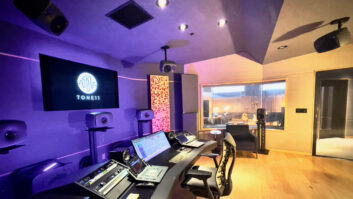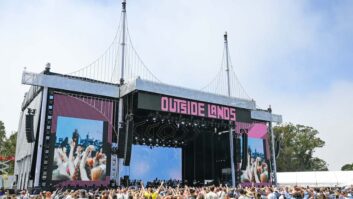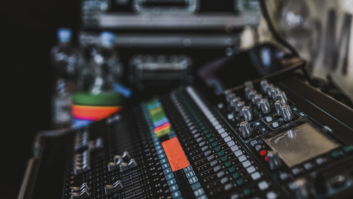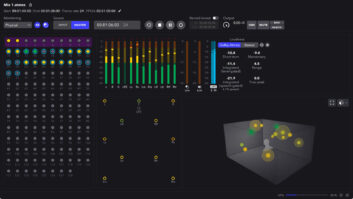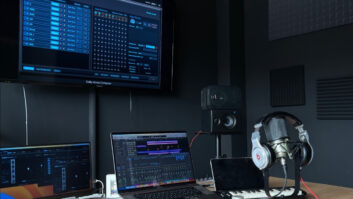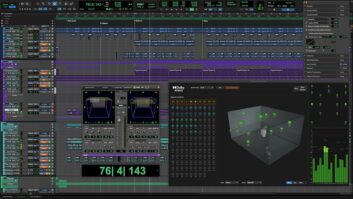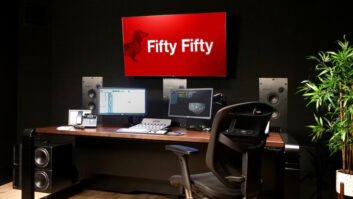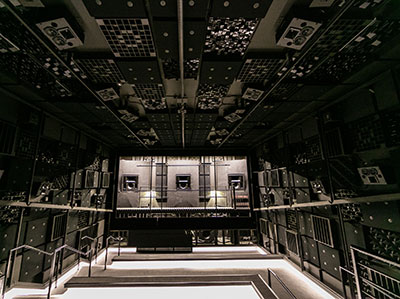
In a semi-dark room on the tenth floor of Dolby’s stunning new headquarters in San Francisco, a young neuroscientist sits on a couch, head and body as still as a mannequin, staring at a pair of High Dynamic Range monitors displaying a stream of computer-generated images—explosions, flames, action and battles. He’s wearing what looks like a swim cap, with multiple sensors and wires attached; more dot his fingers and run up his arms. Specialty glasses, not really goggles, cover his eyes. And while an ATC 9.1.4 Atmos system is available in the NC 10 room, for this experiment he’s listening through headphones.
To his left is a thermal imaging camera, with real-time display outlining his image in yellows, reds and blues, and all their gradations. To his right are two monitors showing graphs and waveforms and numbers, also tracking data in real time. Four more neuroscientists move around the room, checking other monitors.
This is the Bio-Physical Lab, and on this day they’re collecting data on physiological, neurological and, ultimately, multi-sensory response to the impact of changes in video resolution and luminance. For instance, they’ve already found that flames displayed in HDR format will trigger the brain to produce heat in the cheeks. But not in SDR. Tomorrow the team, led by Head Scientist Poppy Crum, Ph.D., might be working on high-resolution audio for mobile or spatialization for multi-talker situations in VR.
It’s all about the study of human perception. And it always has been.
Since Ray Dolby founded the company in 1965 with the introduction of Type A noise reduction, on through AC-3 encoding and its broadcast and cinema variants, up to Atmos playback for the home, the mission, at its root, has always been about achieving a closer approximation of reality. In the beginning, it was all Audio. Then image was added with Dolby Vision. Now it’s the infancy of Virtual and Augmented Reality. If there’s a piece of professional content out there, on physical media or streaming, past, present or future, it likely has some type of Dolby wrapper attached.

Dr. Poppy Crum, Head Scientist, in the Bio-Physical Lab, with 9.1.4 Atmos speaker system (ATC SCM11 speakers and Velodyne Optimum 12 subs). This room works in conjunction with the Sensory Immersion Lab, which has a Meyer Sound Constellation system, along with an internal speaker grid that includes up to 40 custom Pelonis Sound monitors. Photo: Steve Jennings.
“Dolby is a company that thinks about sensory perception,” says Crum, who joined the company five years ago. “Not just audio but the impact of what we see and what we hear and what we experience in order to build technologies that are intelligent in that way. They understand the impact of sensory perception on how you can derive intelligent algorithms and ultimately more successful immersive, impactful experiences in technologies that reach people. Across the gamut. The expansion we’ve had into imaging, I think, is one of the defining features moving forward.”
Today Dolby’s influence reaches across music, cinema, broadcast, gaming, streaming, live events and all sorts of specialty markets—worldwide, with a multiplicity of ever-changing distribution formats, on both the professional creation and consumer playback fronts.
The spread and growth was at times rapid, including an IPO in 2005 and the leasing of multiple locations around San Francisco once the company outgrew its Potrero Street home. Scientists and creators and business units were all spread out. So, about five years ago the company found an appropriate property, and in September 2015, Dolby moved into a 16-story, 300,000-square-foot, 100-lab architectural and technological masterpiece of a building in central San Francisco, referred to by employees simply by its address: 1275 Market.
Dynamic Systems
The goal for the building from the first inter-group planning meetings was to create an environment—aesthetically and technologically—that would stimulate collaboration and cohesion between business groups, and between content creators and scientists. There’s a reason for the tagline Where Science Meets Art. It’s evident in the clean, open architecture, and it’s hidden behind the walls in the core connectivity between labs and listening rooms.

Matt Lavine, CEO Bug ID, in one of the Advanced Technology Group’s ITU NC 10 Critical Listening rooms, with a Revel 9.1.4 Atmos speaker system (9x Salon 2 on floor; 4x Gem 2 in ceiling; 2x Paradigm Subs. Wired for up to 32 channels of passive audio with custom Nion mixer/monitor controller. Photo: Steve Jennings.
“Dolby is always looking to new technologies, for systems that are dynamic,” says Matt Lavine, founder and CEO of Bug ID, design-build system integrator for the project. “They want flexibility. They want an environment for their engineers to be creative and have access to the latest and greatest technologies, to let them create the new latest and greatest technologies. So we created systems that all the end users could use across all the floors. Cinema has different needs than Broadcast, but the core infrastructure and technology behind it can be similar. Engineers can go from one lab to another, or to another group, and understand how the building functions.”
If Dolby were just a research facility, that’s one, albeit large, function. But Dolby engineers’ needs run from standards-critical listening labs to “typical” small, medium and large living rooms; from luminance measurement to Atmos plug-in development.

The Marketing Group’s Studio C, with Avid S6 and API 1608 consoles, 7.1 ATC SCM50 PSL monitor system and 12 on-wall Triad subs, three per wall. Also, Panasonic PTZ cameras and a Tricaster video switcher for recording or streaming. Photo: Steve Jennings.
“There are certain baselines we knew we would have to have for the labs,” Crum says. “We had to be able to support specifications for noise floor levels and room specifications for different international standards that exist. Any developer working in these spaces has to do this. At the same time we need to have rooms to offer flexibility, malleability, and allow for simulation of the types of listening environments that people interacting with our technologies are going to be in, which is very different than a specification in a development lab.”
“We needed technology for where we are right now, and also ensure that we’re set up for the future,” Lavine adds. “We still have to deal with SDI video, AES audio and analog audio, while technology is moving into packetizing the bits and sending to IT. Making sure we had pipe to interconnect floors and send data throughout the building was key.
“Then we developed the system to send MADI, HDMI and SDI to all the labs, where we created multiple machine rooms, each as our hub for a particular floor or a particular room,” he continues. “Our goal was to get as much gear out of the labs as possible. For listening rooms built to an NC10 spec, you can’t have a computer in there. So we remoted everything. There is a large KVM system by IHSE that connects all the computers in the machine rooms.”

John Loose with Erik Foreman and Kevin Perry. Photo: Steve Jennings.
Direct Out Technologies handles all MADI routing, with Andiamo AES-MADI conversion. DSP and EQ are handled through MediaMatrix Nion network routing systems, local to each floor and feeding amplifiers in the critical spaces. Bug ID developed a custom hardware/touchscreen monitor controller to allow users to solo, mute, mixdown 32 channels of audio and grab a volume knob for mixes beyond 7.1. There are dozens and dozens of Lynx Aurora 8-channel converters across all machine rooms; word clock and sync is by Brainstorm.
Still, Dolby is largely manufacturer-agnostic. Lavine says, pointing out that while ATC was the primary speaker vendor, and developed a custom top-firing version for testing and development of Atmos for the home, there are also Dynaudio, Focal, Yamaha, Revel, Paradigm and many others throughout the building, including a Meyer Sound Constellation system for the Sensory Immersion Lab, and 53 Meyer MM4s and 32 subs for Atmos playback in the lobby ceiling, to support the 62-foot, 7 million LED, corner-wrapped video wall.

The VIP Demo Room, with hybrid 9.1.4 Atmos speaker system that switches between ATC custom top-firing and ceiling speakers, with 12 TRIAD subs. Sony 85-inch 4k display. Photo: Steve Jennings.
The Markets
While the architecture and infrastructure are designed to inspire creativity and collaboration, each of the main market segments has a primary floor and dedicated lab spaces. Evan Reiley of Shen Milsom & Wilke, LLC was the acoustician for the whole building, bringing a consistency to the listening experience from top to bottom.
The Advanced Technology Group is on floors 9 and 10, for example, working in R&D out of a number of sound labs, the most premium ones being a pair of NC10 listening labs, the Bio Physical Lab, and a first-floor Sensory Immersion Room, outfitted with a Meyer Constellation system to change the acoustic environment electro-acoustically, along with an interior cage to play back Atmos material from 40 Pelonis Sound custom monitors based on the signature Model 42s but with extended low end and greater overall output, in the same compact form. It’s the tallest of all the labs. It was said to measure NC2.

From left, Bug ID AV System Engineer Ross Yeo, Bug ID CEO Matt Lavine and Bug ID Project Manager Quincy Kowolik in the building’s art-centric lobby, in front of a corner-wrapped video wall made by Silicon Core: 1.9mm LED panels; 62 feet long by 4.5 feet tall; 9,920 pixels wide by 720 pixels high; and 2,000 NITS max brightness. The sound system consists of 52 Meyer MM4 XP speakers and 35 Meyer UMS-1XP subwoofers, all in the ceiling. Photo: Steve Jennings.
Home, Mobile, Tablet Gaming, Virtual Reality and associated consumer-centric markets are under the umbrella E-Media, on Floor 8, working out of living room-style labs, with top-firing speakers and headsets. Broadcast is on Floor 7, and with all of its worldwide formats and sync issues, proved one of the more challenging machine rooms.
Cinema is on Floor 5, with two Atmos mixing/authoring rooms, 10 bays for digital projection and two additional Content Creation Labs below ground level—full-blown dub stages with Avid System 5 consoles and Meyer Acheron 80 LCR monitoring, with HMS5s for surround.
And finally, the Marketing Group is on Floor 3, where 20-year Dolby veteran John Loose oversees the Recording Studio, VIP Demo Room, and production and post for Dolby-generated materials—from theatrical trailers to product launches to the Atmos mixes for rotating digital arts exhibits across 62 feet and around a corner in the lobby. He also brings string quartets from the SF Conservatory in to record.

One of two identical rooms in the Cinema Group for mixing/authoring. Each room has a Meyer Sound Acheron/HMS5-based Atmos system, with one front and one rear X400C sub. This room has an Avid S6 and 4K LED monitor. Photo Courtesy of Dolby Laboratories.
The studio includes a generous tracking room, easily big enough for a five-piece rock band, with six mounted tilt-pan-zoom cameras that feed a Tricaster for live streaming. A huge iso booth, to NC6 spec, can handle drums or Foley or ensemble voices. A smaller vocal booth is also dead quiet.
The control room is very large, featuring an Avid S6 console with an API 1608 acting as a front end, a combination Loose fell for when working with the Killers in Las Vegas on a surround project. Everything gets converted and goes into the Peavey Nion for EQ and levels, then the A-to-D conversion via Lynx Aurora and out to the amps feeding the ATC SCM50 7.1.4 monitor system with 12 Triad on-wall subs, behind the fabric, four per wall. Loose’s right hand man, Kevin Perry, was instrumental in working with Lavine and team on the integration.
Loose also manages the VIP Demo Room, also fed by the Nion processor, allowing for playback of variable speaker configurations, including the ability to switch from a 9.1.4 top-firing ATC Atmos system on the floor to a 9.1.4 ceiling-mounted ATC system at the touch of an iPad, with Crestron back-end.
The Future
Dolby is so many things today. But more than anything, it’s a company that releases and promotes Immersive Sound, while researching Total Immersion. Science begets Technology begets Art. But it all starts with Science.
Poppy Crum is a most interesting neuroscientist. She attended McGill University to study music (she plays violin) and recording, and at age 17 traveled to San Francisco for her first AES Convention. She was already enamored of Dolby and the manner in which they approached research in human perception. “They were unique as a company, even back then, in thinking about the human system and perceptual response to drive their algorithm development,” she says.
She later got a master’s degree in experimental psychology at McGill, followed by a Ph.D. from UC Berkeley in neuroscience and psychology. From there she joined the Research Faculty at Johns Hopkins School of Medicine in the Department of Biomedical Engineering. Five years ago she was recruited by Dolby. She has since assembled a team that includes Grant Mulliken, Ph.D. (background in chip design, brain-computer interfaces, and neural representations of visual attention); Dan Darcy, Ph.D. (neural correlates of vision, olfaction, and neurogenesis); Alex Brandmeyer, Ph.D. (auditory neuroscience, music, brain-computer-interfaces, auditory perception); and Evan Gitterman, BSc (cognitive science, neuroscience, and music); among many others in support.
“Whether it’s behavioral or physiological, you have to know how a human system interacts with the world and the content around them—the audio or video or multisensory,” she says. “That understanding is the experiential capture that we’re targeting, and it definitely informs our development process. You do want to know what people think, what people like. Those are important data points. But what you want to know is what they perceive, and what they experience; what their system experiences.
“I have huge respect for sound designers,” she adds. “They may not speak in the same vocabulary I speak in, but they have an expert understanding of human perception. The ability to take sounds from many different sources but recognize the experiential representation that someone listening to a film is going to have is at the core of human experience. And they understand that innately.”
For Lavine and the team at Bug ID, the job has finally wound down after nearly three years. One of Bug ID’s system designers for the project has made the move to Dolby full time to help maintain system continuity. It has been beneficial for both companies. It was a huge challenge for a relatively small integration firm, with attendant risks on both sides. But Lavine had some experience with the company, dating back seven years to a campus build-out in the Sunnyvale location, followed by a couple of suites in Burbank, so he had an idea of their approach. It has all come together beautifully, in form and function.
“I still get such a reward when I walk into a room and see people creating, using the technology,” Lavine says. “Our goal was to give them the tools to create, to give them an environment as flexible and user-friendly as possible. We knew it was going to be huge back when we started in 2013, and now that we have pulled it off, it feels good.”
